Financial Forecasting
An estimation process regarding a company’s future operational and financial performance derived from various analyses.
What is Financial Forecasting?
Financial forecasting is a process in which estimations regarding a company’s future operational and financial performance are derived from various analyses.
Creating a financial forecast allows businesses to understand where they are currently positioned and headed. A company can ascertain answers to various questions about the future through projections.
Executives use forecasting to project a variety of important financial measures such as revenue, net income, SG&A (Selling, General, and Administrative expenses), gross profit margin, and net profit margin. In addition, analysis of projections offers management the opportunity to make fundamental operational changes to achieve a business’s goals.
Creating a financial forecast grants companies the ability to derive projections from data instead of desire.
For example, creating a financial forecast allows companies to derive projections from data rather than desire, based on quantitative information for increased accuracy, conservatism, and rationality.
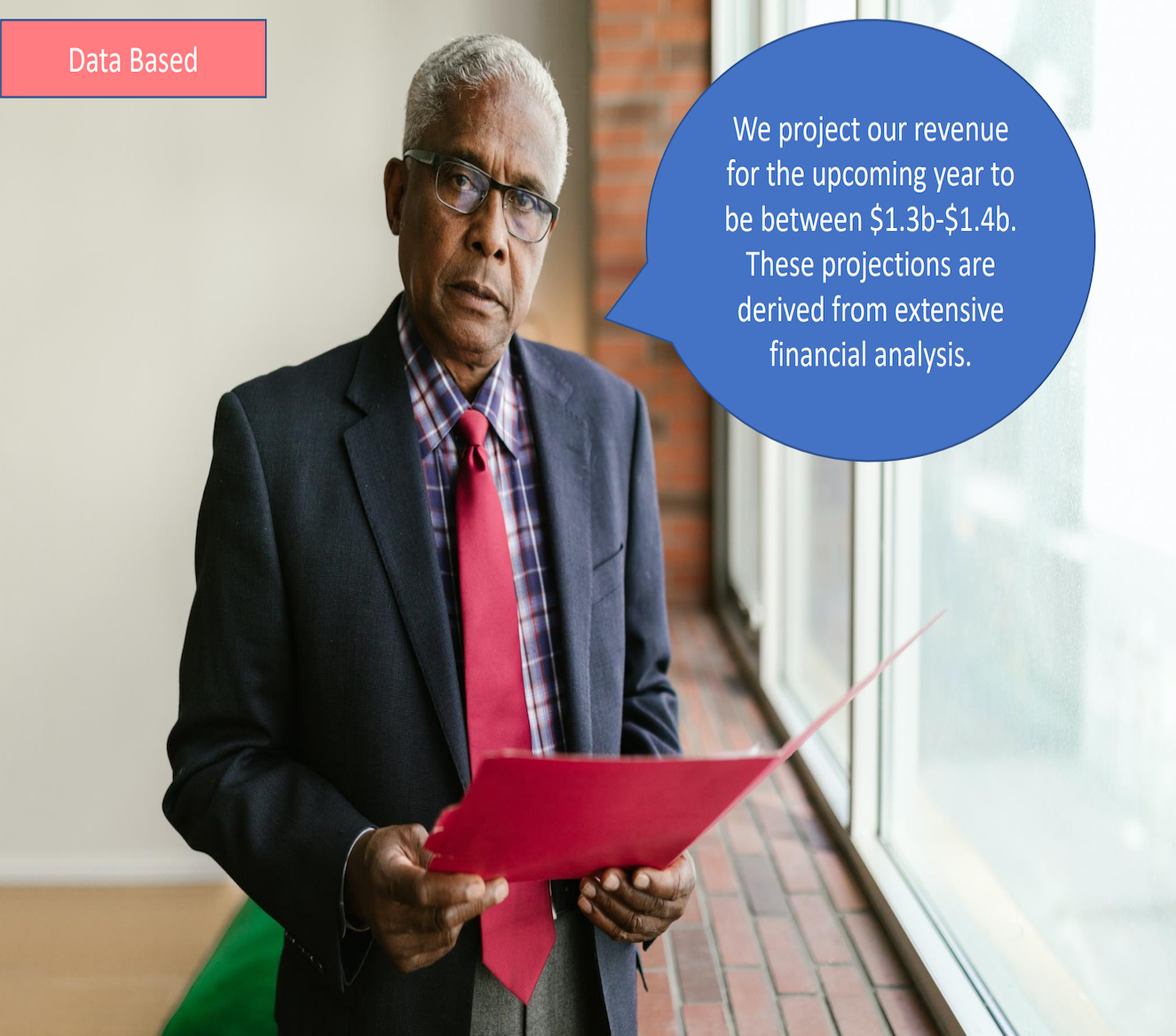

A company’s forecast can also be a productive medium for communicating expected financials to investors. Analysts can weigh their financial models against a business’s forecast to extrapolate a more accurate future share price.
This dynamic creates the opportunity for companies to build investor trust.
For example, if a company has historically provided accurate forecasts, analysts attribute greater credibility to present-day forecasts. Likewise, if past financial results have missed their mark relative to projections, analysts will deem a company’s present-day forecasts to be unreliable.
Key Takeaways
- Financial forecasting involves estimating a company's future operational and financial performance through data analysis.
- The process provides insights into the company's current position and future trajectory, helping executives make informed decisions.
- Executives use forecasting to project various financial measures such as revenue, net income, expenses, gross profit margin, and net profit margin. Accurate forecasting allows for fundamental operational changes to align with business goals.
- Effective financial forecasts are data-based, relying on quantitative information for increased accuracy, conservatism, and rationality.
How to create a financial forecast?
The process for creating a financial forecast consists of 6 steps:
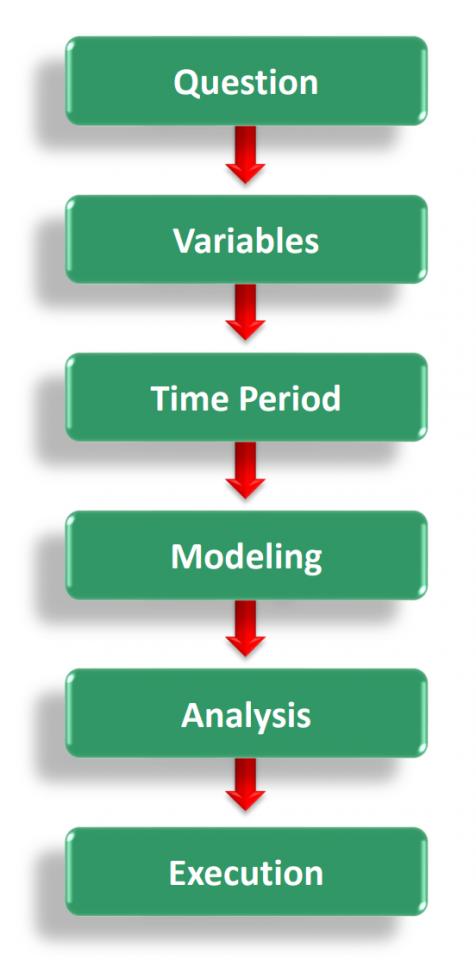
- What is the question?: Before analyzing any financial data, one must know what they are looking for. A question relevant in forecasting maybe, “If we increase R&D by 15% next year, how would that affect net income?” or “If the federal funds rate were to rise to 6%, how would that affect our ability to service our debt payments?”
- What are the variables?: Specific data sets and relevant financial information are selected to answer the question posed in step #1.
- Select a time period: After choosing what data and financial information are essential for this specific forecast, one must decide what time period to select from this information. Data from 15 years prior may not be relevant anymore, and the same may go for financial results.
- Select and create a model: The proper model for analyzing the relevant data is chosen. Forecasts are created using various methods, including statistical analysis, to answer the proposed question in step #1.
- Analysis: Once the model has been completed, it is time to analyze it. In this phase of the process, conclusions are drawn from the model’s output, providing insights into the company's strategic direction.
- Execution: The forecast is presented to upper management. Management considers the projection and implements new policies and procedures to assist the company’s trajectory.
Importance of Financial Forecasting
Let’s look at some of the importance of the financial forecasting below:
- Annual Budget Planning: Financial forecasting and annual budget planning go hand in hand, ensuring that budgets reflect realistic future scenarios. Forecasting transforms budgets into strategic roadmaps by offering insights into a business’s financial future.
- Realistic Business Goals: Accurate forecasting enables businesses to predict growth or decline, setting the stage for establishing achievable goals. This foresight aligns targets with financial outlooks, fostering a proactive approach to goal-setting.
- Identifying Problem Areas: As a diagnostic tool, financial forecasting analyzes past performance and anticipates future challenges, allowing proactive problem-solving and enhancing overall resilience.
- Risk Reduction: Financial forecasting mitigates risks associated with overspending and ill-informed decisions, aligning budgets with prudent, informed financial strategies.
- Investor Appeal: Investors rely on financial forecasts to predict performance and potential returns, making regular forecasting a key factor in showcasing control, preparedness, and a solid business plan.
Types of Financial Forecasting
There are a variety of forecasts that companies can use to project their financial future. Selecting the specific type of forecast is crucial for efficiently and accurately answering any proposed question when it comes to forecasting. The various types of forecasts include traditional, rolling, predictive, and exception-based.
Traditional Forecast
This forecast involves using historical financial results and data to create a fixed projection. It produces projections for various financial items such as revenue, cost of goods sold, net income, etc.
The problem with this type of method is that the projections are fixed. If an unforeseen event occurs, it will be challenging to adjust the model and often result in the company having to make an entirely new model.
Rolling Forecast
It offers a solution to the issue that arises with traditional forecasting. A rolling forecast takes into account new data and financial returns. The model is regularly updated on a time basis set by the company. It may be updated daily, weekly, monthly, or quarterly, depending on company preferences.
It allows a company to adjust for unforeseen events without having to make a new model.
This method can improve management decisions by providing a dynamic and regularly updated screenshot of the company’s current financial state. Based on the interpretation of the forecast, management can adapt quickly and implement operational changes.
Predictive Forecast
This method uses machine learning to create a forecast. Using artificial intelligence to gather and analyze data, a predictive forecast can provide insights that would have gone unnoticed using the previous forecasting methods.
It can be less work for employees, and the forecast can be produced on a faster timeline relative to traditional forecasting.
Predictive models often employ algorithms for data analysis, such as the random forest algorithm, which uses decision trees to observe an item or branch and then output a conclusion, which is displayed in the leaves.
Other algorithms regularly used are the generalized linear model, the gradient-boosted model, the prophet model, and the k-means clustering method.
To learn how to implement machine learning within a forecast, look into the following course.
Exception Based Forecast
This method uses scenario analysis to create a forecast that can be adaptable to various potential events. It allows management to identify what the company’s financial results may look like under different circumstances.
The selection of a forecasting method is decided at the discretion of a company’s management. As a result, some companies may choose to implement multiple forecasting methods, and some may only choose to use one.
As the company grows, it requires more inputs and must address an increasing number of potential hurdles, all recognized within the forecast.
A strong forecast must include a thorough set of data and financial results to draw upon, a time horizon that points toward the future, and a variety of scenarios and their potential effect on company operations. In addition, a strong forecast should account for external and internal risks that have the potential to threaten profitability.
Types of Forecasting models
Various models can be used to project and analyze data or financials within a forecast.
These models are commonly built using Microsoft’s Excel software. Using models can increase accuracy by basing projections upon mathematical formulas instead of management desire.
Models that are frequently used for forecasting include:
- Straight-Line method
- Moving Average method
- Linear Regression method
- Delphi method
Straight Line Method
This model takes historical financial results or data and measures the historical growth rate. The growth rate is then used to project the financial results or data into the future to create a forecast. It assumes that past results will continue to be similar in the future.
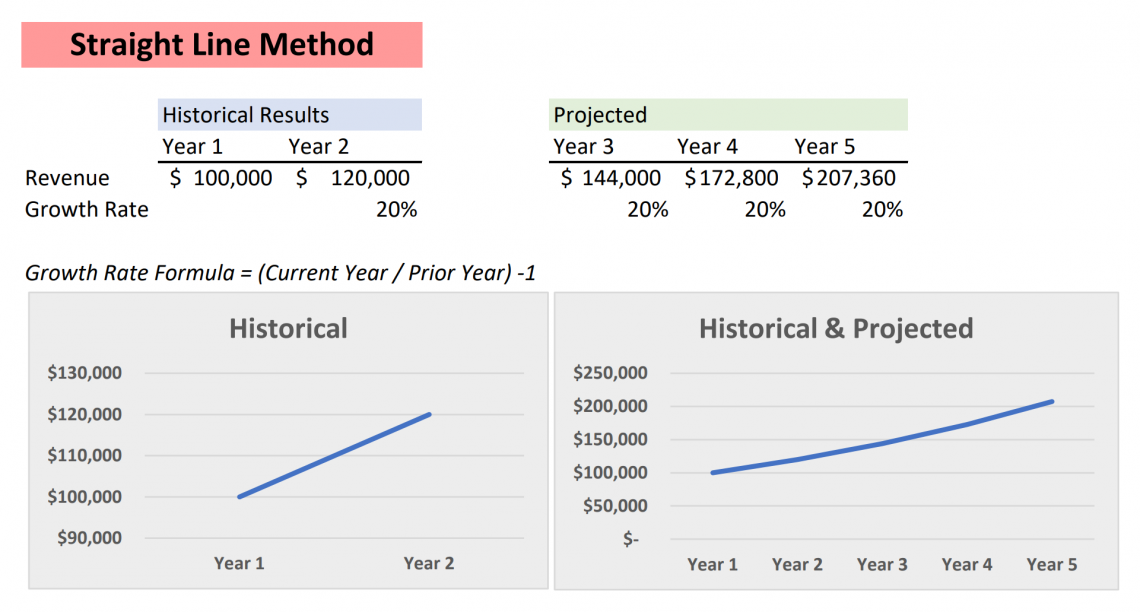
The trouble with this model is selecting the proper time period to analyze. It is prudent to determine which historical data is relevant to the company and which historical data should be disregarded.
To calculate the growth rate, divide the current year’s result by the prior-year result and subtract 1. To project into the future, multiply the prior-year result by 1 plus the growth rate.
To use the growth rate to project into the future, multiply the prior-year result by 1 plus the growth rate.
Moving Average Method
This type of model measures recent patterns in data through averaging results. The model smooths out the volatility of data points, allowing a better assessment of current trends.
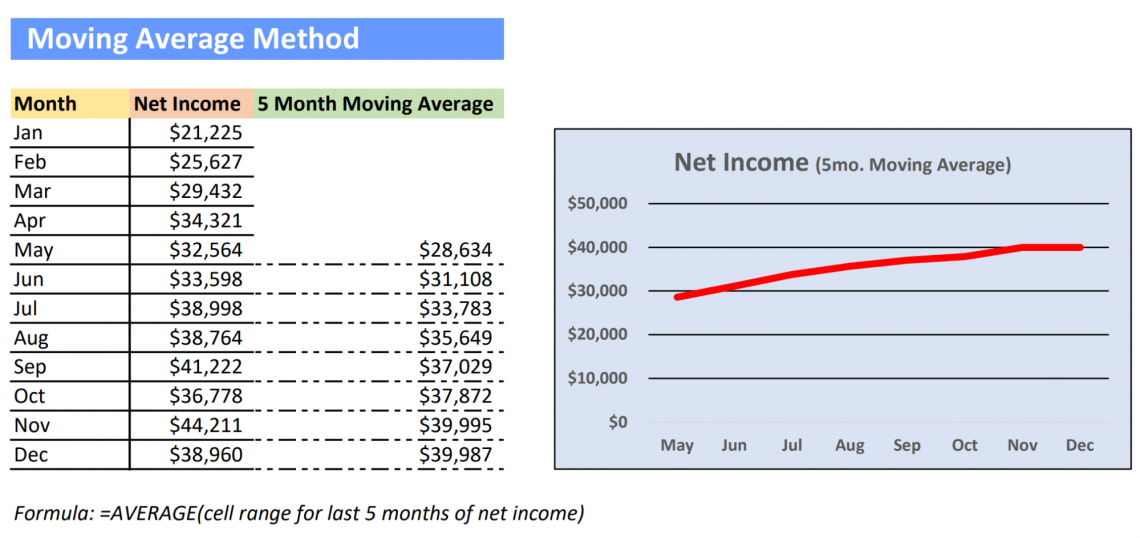
Often, companies will use 5-month moving averages or 3-month moving averages, although the method can be used on shorter time frames if desired.
Using the moving average method to help a company identify trends in key financial measures such as revenue, cost of goods sold, or new subscriptions. To derive a 5-month moving average, take the average of a data point over the last 5 months.
Linear Regression Method
This type of model creates a visual relationship between two variables. One variable is the dependent variable mapped out on the Y-axis.
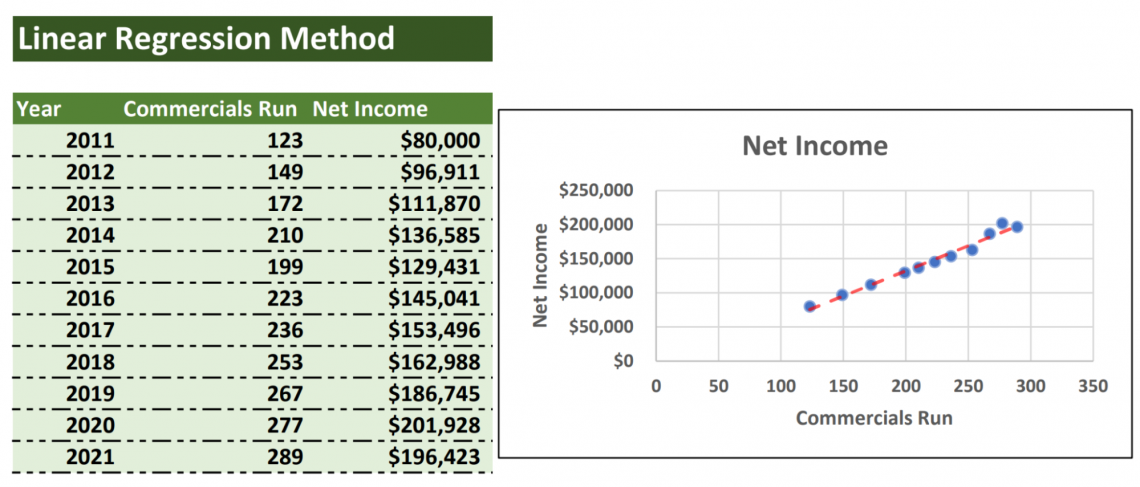
The other variable is an explanatory variable mapped out on the X-axis. After the data points have been placed onto a graph, a line can be drawn between the points, illustrating a pattern or trend.
This type of analysis allows a company to understand the relationship between multiple financial items.
The Delphi Method
The Delphi method more closely resembles a framework for modeling within the forecasting process as opposed to a model created within a spreadsheet. This method does not create a model based on any mathematical formulas. It creates a model based on the consensus of opinions.
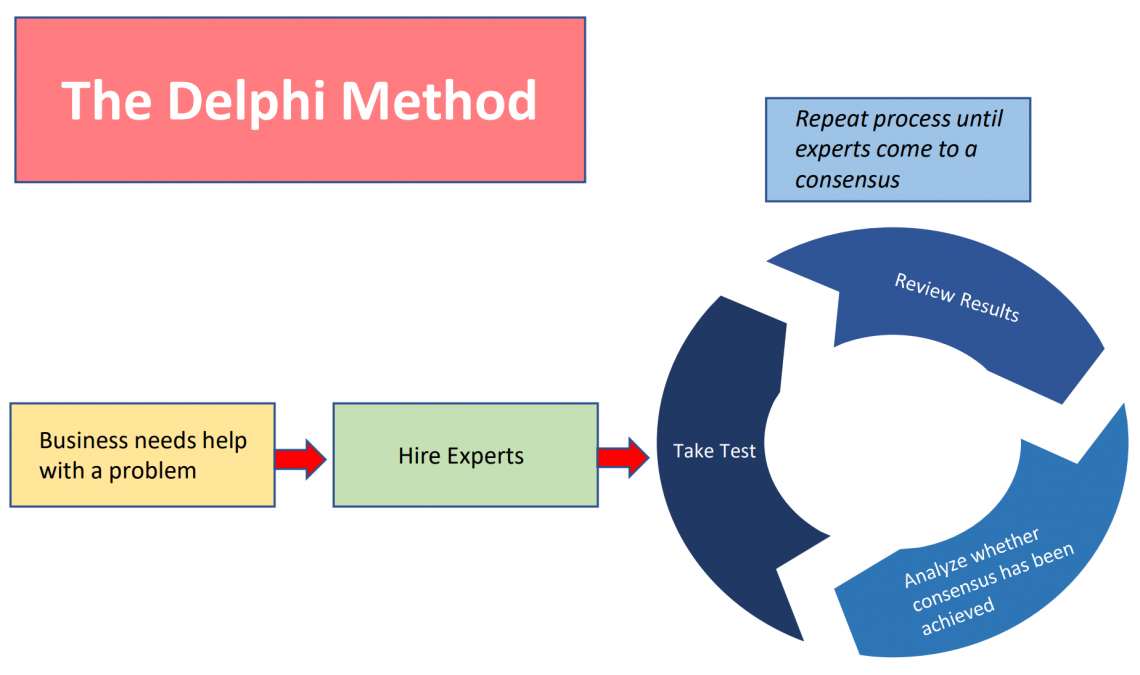
The Delphi Method uses a large group of experts to answer a question proposed by a company. The experts take a test and collectively review the answers alongside a moderator. If the experts can agree, then the company has its response. If not, the experts retake the test.
This process is repeated until a conclusion is reached.
The Delphi method is based on the concept of ‘wisdom of the crowds,’ suggesting that people collectively make smarter decisions in larger groups than in smaller groups or individually.
Financial Forecasting vs. Modeling
An important distinction is the differentiation between forecasting and modeling. While they share many similarities, leading many to perceive the two as indistinguishable, in reality, they are quite different.
Below, we look at brief descriptions of the two and the differences between them.
| Aspect | Financial Forecasting | Modeling |
|---|---|---|
| Definition | Process projecting future business operations | Part of forecasting involving data and financial analysis |
| Goal | Prepare a company for the future | Assist in determining the trajectory of business |
| Involvement of Data | Utilizes data analysis | Involves data analysis and financial analysis |
| Conceptual Process | Utilizes data analysis and financial analysis | Part of the forecasting process |
| Relationship to Models | Involves modeling as a step | Integral part where mathematical formulas are applied |
| Types of Models | Straight line method, Moving average method, Linear regression method, Delphi method (resembles a model) | Unlimited types, common ones include: Straight line, Moving average, Linear regression, Delphi method |
| Delphi Method | Resembles a model, even though it does not employ data analysis | Represents useful information in an organized manner, similar to a model |
| Output | Determines expectations for a company’s future outlook | Assists management in more accurately forecasting future financial results |
| Implementation | Tangible changes in business operations based on model results | Utilized to assist management in forecasting future results |
Financial planning and analysis (FP&A)
The Financial Planning and Analysis team (FP&A) is the group that will run financial forecasts most of the time within an organization. This team will move through the entire forecasting process and be responsible for effectively communicating the results to the company’s executive management.
The involvement of the FP&A team enables executive management to make better decisions and more accurately inform investors and shareholders about company operations and financial results.
The primary responsibilities of the FP&A team are:
- Create forecasts and budgets
- Inform senior management, in particular, the chief financial officer (CFO)
- Analyze historical financial returns
- Utilize data analysis to make informed decisions
- Account for potential risks that pose a threat to the company’s financial health

The FP&A team will analyze data and financials to create successful budgets and forecasts. For example, if a company implements rolling forecasts, the FP&A team is responsible for monitoring and updating financial models.
Often, the company’s management will develop a plan for the direction they would like to take the company. This direction includes future financial results based on key items such as revenue, net income, and share price.
The FP&A team is responsible for thoroughly analyzing this plan and creating forecasts and budgets that accurately align with management’s goals.
The FP&A team will dictate in their analysis how business operations must change for the executive’s objectives to be accomplished.
An analyst's ability to communicate effectively is the most crucial aspect of working within FP&A. It is not enough to have a fantastic financial model; but the analyst must be able to convey information to the senior management productively.
The goal is to use the data to tell a story. This format allows quantitative findings to be efficiently digested, increasing the chance of implementing operational changes.
Let's take a look at some of the different roles and the median salary according to the roberthalf website for 2024:
| Role | Median Salary ($) |
|---|---|
| FP&A Analyst, 3-5 Years Experience | 89,500 |
| FP&A Analyst, 1-3 Years Experience | 77,250 |
| Senior Financial Analyst | 95,250 |
| Financial Analyst, 1-3 Years Experience | 77,000 |
| Entry-Level Financial Analyst | 59,500 |
| Senior Budget Analyst | 95,250 |
| Budget Analyst, 1-3 Years Experience | 77,000 |
| Entry-Level Budget Analyst | 59,500 |
Problems with Financial forecasting
Many of the issues inherent in forecasting derive from two unfortunate truths.
- Uncertain Future: Despite accurate inputs, the future remains unknown. While financial models provide insights, there’s a fine line between viewing forecasts as likely scenarios and concrete predictions. Methods like straight-line or moving averages may not ensure future alignment with past results.
- Subjectivity in Forecasting: Analysts’ formula choices influence outcomes, introducing subjectivity. Whether from past performance or other metrics, growth rate derivation is inherently subjective. Operational changes based on forecast interpretation also hinge on subjective decisions.
- Additional Issues
- Black Swan Events: Unforeseen occurrences, like the 2008 financial crisis or COVID-19, challenge forecasts, inherently carrying potential errors.
- Delphi Method: While valuable for insights, dependence on expert opinions poses challenges. The wisdom of the crowd theory, assuming collective intelligence, isn’t foolproof, which is evident in historical instances like Tulip Mania and the dot-com bubble.
More about financial modeling
To continue learning and advancing your career, check out these additional helpful WSO resources:
















or Want to Sign up with your social account?